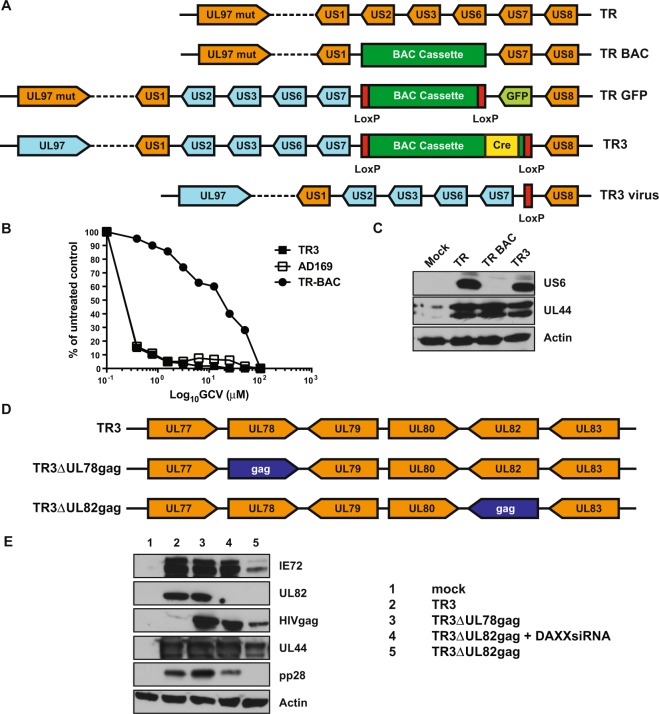Figure 1.
Construction and in vitro characterization of HCMV TR3. (A) Sequential construction steps resulting in TR3. The original isolate TR72 was cloned by replacing the US2-6 region with a BAC cassette resulting in TR-BAC16. TR-GFP was generated by inserting loxP sites flanking the BAC cassette, replacing US7 with a GFP expression cassette and inserting the US2-7 region of AD16918. TR3 was generated from TR-GFP by deleting the GFP cassette, inserting a Cre-expression cassette into the BAC cassette and by replacing the defective UL97 with intact UL97 of AD169. The BAC cassette in TR3 is self-excising resulting in a residual loxP site upon reconstitution of virus. (B) TR3 is sensitive to Ganciclovir. Human MRC-5 fibroblasts were infected with the indicated viruses at MOI = 0.5 in the presence of decreasing concentrations of Ganciclovir. Culture supernatants were harvested when controls showed full cytopathic effect and the amount of viral progeny produced was quantified by standard plaque assay. Results are shown as percent of untreated control. (C) US6 expression by TR3. MRC-5 cells were infected or mock infected with the indicated viruses at MOI = 0.5. At 96 h after infection, cells were harvested and cell lysates were electrophoretically separated and probed for expression of the indicated viral or host proteins by immunoblot. The blots for each protein are shown as cropped from different parts of the same gel. (D) Design of TR3ΔUL78gag and TR3ΔUL82gag. (E) Viral protein expression in the absence of pp71. MRC-5 cells were infected or mock infected with the indicated viruses at MOI = 0.5 in the presence or absence of DAXX-targeting siRNA. Cells were harvested at 96 h post-infection. Cell lysates were electrophoretically separated and probed for the indicated viral and cellular proteins by immunoblot. The blots for each protein are shown as cropped from different parts of the same or different gels separating the same lysate. HIVgag was detected using a polyclonal antiserum to the p24 subunit.

